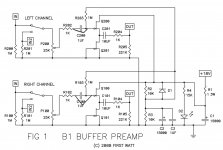ok thx..now i am thinking about symmetrical supply b1 buffer.i didnt understand why nelson used capacitors ?
Because its unconditionally safe for not passing/producing DC in any bad source occurence or failure circumstance, which can lead in electrodynamic speaker destruction if used with DC coupled amps like the F5.
i can print and do myself because of shipping etc expensive..which one is better ? and do they work?
This is not the thread for that. Moving your question to the dedicated thread.
ok thx i deleted the message..i just wanted to learn..i will use it with f5 amp..my emu1212m sound card can not feed f5 amp well
sorry for silly questions but i wanna learn what happens if i dont use 1uf capacitor at the input?..isnt it enough to be safe only using 10uf cap at the output?
See where the 1M resitor is referenced. Half psu. So you get it on your input, if you skip the 1uF.
yes now i see..what happens if we do not bias with 1M resistor? because you didnt use 1M on the symmetrical buffer circuit?
It simply will not work. Has to be referenced somewhere. With single supply that is half psu. You mix two different things. The symmetrical psus allow no input or output caps. The single ended psu does not. Its either you make the original B1 or the symmetrical supply spin off. Using an output capacitor for the symmetrical one is pure precaution with DC coupled amps like the F5. Using both input and output caps on the original B1 is mandatory.
oww yes i see now..i forgot the topologies but now i remembered..for single supply ,sinusoidal signal plus dc together goes into the jfet and output cap filters dc..yes i see.thank you
B1 in an active filter?
The B1 buffer is essentially a voltage follower.
A voltage follower is also an essential part of a Linkwitz-Riley filter.
See this: Active Filters
Has anyone tried the B1 voltage follower as a component in a Linkwitz-Riley filter?
The B1 buffer is essentially a voltage follower.
A voltage follower is also an essential part of a Linkwitz-Riley filter.
See this: Active Filters
Has anyone tried the B1 voltage follower as a component in a Linkwitz-Riley filter?
B1-converted D/A-converters?
Lampizator is a CD-player or a DAC modification. The idea is to replace the active op-amp filters and buffers after the D/A-converter with a single-ended triode amplifier stage, thus avoiding numerous transistor stages of the op-amps.
I thought that basically the same could be done with a simple Class A JFET amplifier, possibly using a B1 stage. Because B1 is a voltage follower buffer, it could be developed to a Linkwitz-Riley low-pass filter, like I said in my previous post.
Read this too: http://www.diyaudio.com/forums/tubes-valves/153345-how-lampizator-cd-tube-player-sound.html
Lampizator is a CD-player or a DAC modification. The idea is to replace the active op-amp filters and buffers after the D/A-converter with a single-ended triode amplifier stage, thus avoiding numerous transistor stages of the op-amps.
I thought that basically the same could be done with a simple Class A JFET amplifier, possibly using a B1 stage. Because B1 is a voltage follower buffer, it could be developed to a Linkwitz-Riley low-pass filter, like I said in my previous post.
Read this too: http://www.diyaudio.com/forums/tubes-valves/153345-how-lampizator-cd-tube-player-sound.html
This is a perfect application for a B1 type circuit. For LR4, you probably need 3 B1 circuits, one as input buffer and another for every L2 Butterworth stage.The B1 buffer is essentially a voltage follower.
A voltage follower is also an essential part of a Linkwitz-Riley filter.
See this: Active Filters
Has anyone tried the B1 voltage follower as a component in a Linkwitz-Riley filter?
HTH
Doug
The B1 buffer is essentially a voltage follower.
A voltage follower is also an essential part of a Linkwitz-Riley filter.
See this: Active Filters
Has anyone tried the B1 voltage follower as a component in a Linkwitz-Riley filter?
I agree, it seems like an ideal application for B1. It is on my list of things to do "real soon now".
I agree, it seems like an ideal application for B1. It is on my list of things to do "real soon now".
I don't really know what i'm doing, but in LTSpice I knocked up a pair of Salas's direct-coupled B1-type buffers in 24dB L/R high-pass, and apart from an enormous insertion loss, it performs as I expected. Oh, and with more than 0.015% THD+N @10kHz but I suspect that's due to the sim looking at everything up to 200kHz. I'd really like to build this to test it, as I'm keen on attempting to bi-amp my system. Should I start a thread on it? I haven't managed to find anything really complete on the 'net so far (so far~) about active crossovers without opamps.
Last edited:
...a pair of Salas's direct-coupled B1-type buffers in 24dB L/R high-pass, and apart from an enormous insertion loss, it performs as I expected...
I don't see any reason for this insertion loss. And as far as I remember, there was none in my simulations. I think you did something wrong.
Oh, and with more than 0.015% THD+N @10kHz but I suspect that's due to the sim looking at everything up to 200kHz.
You should not trust the THD+N simulations of spice too much. Just regard it as a tendency.
regards
Flo
in the passband of each part of the crossover there should be near zero insertion loss.
You either (virtually) wired it up wrong or you asked the simulator the wrong question.
You either (virtually) wired it up wrong or you asked the simulator the wrong question.
Figured it out, crossover resistor values were too low compared to the input 'stopper'... less than 1dB loss now.
- Home
- Amplifiers
- Pass Labs
- B1 Buffer Preamp
